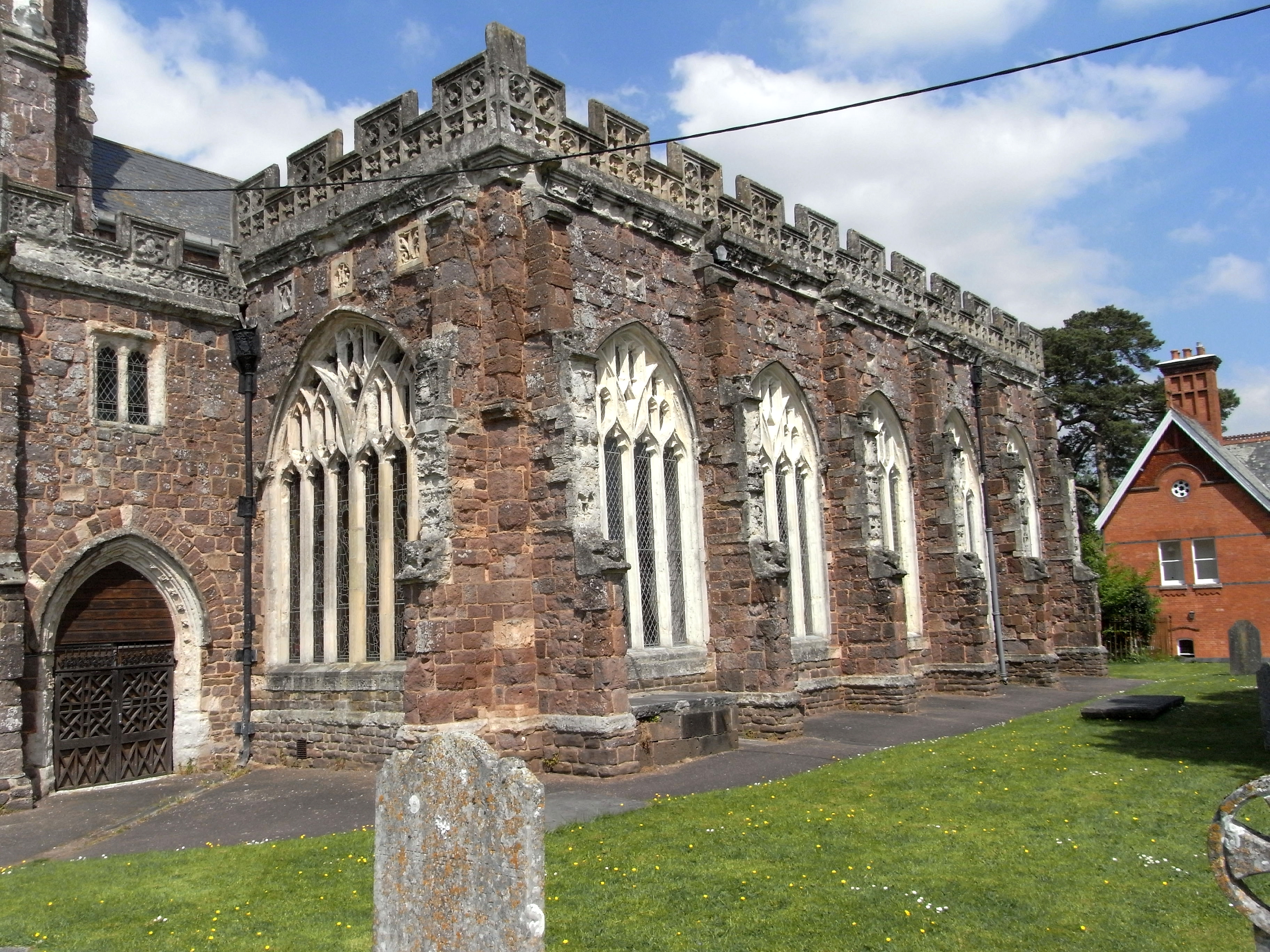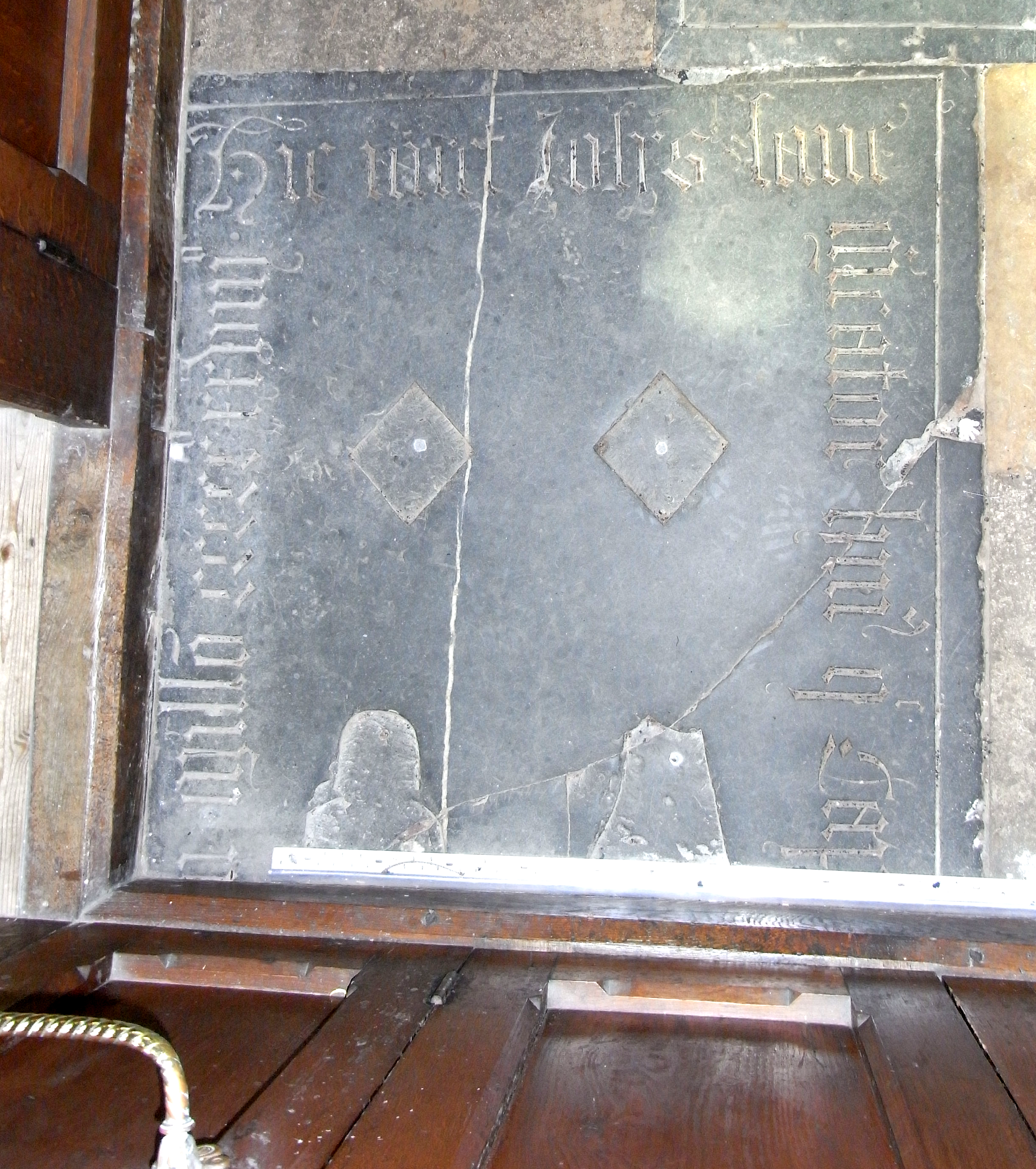John Lane (clothier) on:
[Wikipedia]
[Google]
[Amazon]


 John Lane (died 1528) was a wealthy clothier from
John Lane (died 1528) was a wealthy clothier from
:"Plaintiff: Thomasyne late wife of John Lane, of Cullompton; Defendant: Humphrey More, John More, Christopher More, and John Smyth. Place or subject: Forcible entry into a chapel built by plaintiff's late husband adjoining to the parish church".
 He was buried at the east end of his Chapel, where survives his ledgerstone, in the middle of the aisle and now mostly covered by box-pews and missing the
He was buried at the east end of his Chapel, where survives his ledgerstone, in the middle of the aisle and now mostly covered by box-pews and missing the
:''Hic jacet Joh(anne)s Lane, M(er)cator, huiusq(ue) capellae fundator cum Thomasi(n)a uxore sua, qui dict(us) Johan(nes) obi(i)t XV. Feb(ruarii) annoque Dom(ini) mill(ensim)o CCCCCXXVIII''. ("Here lies John Lane, merchant, founder of this chapel, with Thomasine his wife, which said John died on the 15th (day) of February in the year of our Lord the one thousandth five hundredth and twenty eighth").
:"In honor of God and his blessed Mother Mary, remember the soule of John Lane (with a Pater Noster and Ave Mary)(
Cullompton
Cullompton () is a town and civil parish in the district of Mid Devon and the county of Devon, England. It is north-east of Exeter and lies on the River Culm. In 2021, the parish as a whole had a population of 10,071, while the built-up area o ...
in Devon, remembered today for having built the magnificent ''Lane Chapel'' (or ''Lane Aisle'') on the south side of St Andrew's Church, Cullompton. Due to a misreading of the inscription on the exterior of his Chapel he was said by Polwhele (1793) to have occupied the office of ''Wapentake
A hundred is an administrative division that is geographically part of a larger region. It was formerly used in England, Wales, some parts of the United States, Denmark, Sweden, Finland, Norway, and in Cumberland County in the British Colony of ...
Custos, Lanarius'', (translated as "Constable of the Hundred
100 or one hundred (Roman numerals, Roman numeral: C) is the natural number following 99 (number), 99 and preceding 101 (number), 101.
In mathematics
100 is the square of 10 (number), 10 (in scientific notation it is written as 102). The standar ...
, wool merchant"). However no historical evidence supports the existence of such an office and the inscription was later correctly re-interpreted by Smirke (1847).
Lane Chapel
The Lane Chapel is a grand structure of five bays with large windows and a magnificent fan-vaulted ceiling. Building work commenced in 1526 (as is stated on the lengthy inscription on the external walls), two years before Lane's death, was continued by his widow Thomasine and finished in 1552, according to an inscription on the exterior of the east wall. It is profusely embellished in the interior on the ceilingcorbel
In architecture, a corbel is a structural piece of stone, wood or metal keyed into and projecting from a wall to carry a wikt:superincumbent, bearing weight, a type of bracket (architecture), bracket. A corbel is a solid piece of material in t ...
s and bosses with relief sculptures of angels holding Lane's merchant's mark. The exterior walls are embellished with relief sculptures (now severely worn away by the elements) of biblical scenes and of items related to Lane and his trade, such as ships, cloth shears, teasel frames, merchant's mark
A merchant's mark is an emblem or device adopted by a merchant, and placed on goods or products sold by him in order to keep track of them, or as a sign of authentication. It may also be used as a mark of identity in other contexts.
History
...
s, monogram
A monogram is a motif (visual arts), motif made by overlapping or combining two or more letters or other graphemes to form one symbol. Monograms are often made by combining the initials of an individual or a company, used as recognizable symbo ...
s, etc. A lengthy relief-sculpted inscription in English in black-letter Gothic script runs around the three exterior walls of the building, low-down beneath the windows (see below).
The ''Lane Chapel'' is comparable in many respects to the nearby ''Greenway Chapel'' and ''Greenway Porch'' in St Peter's Church, Tiverton, built in 1517 by his contemporary fellow merchant John Greenway (died 1529).
Dispute with Moore family
At the east end of the opposite (north) aisle of Cullompton Church is situated theMoor Hayes
Moor Hays (''alias'' Moore Hays, Moorhays, Moorhayes, etc.) is a historic estate in the parish of Cullompton in Devon, England. It is stated incorrectly to be in the nearby parish of Burlescombe in Tristram Risdon's ''Survey of Devon''. The es ...
Chapel, anciently the property of the Moore family of Moor Hayes, within the parish, lords of the manor
Lord of the manor is a title that, in Anglo-Saxon England and Norman England, referred to the landholder of a historical rural estate. The titles date to the English Feudalism, feudal (specifically English feudal barony, baronial) system. The ...
of Cullompton. Lane's widow had a dispute with this family concerning their trespassing into the Lane Chapel, which resulted in a law suit heard by the Star Chamber
The court of Star Chamber () was an English court that sat at the royal Palace of Westminster, from the late to the mid-17th century (), and was composed of privy counsellors and common-law judges, to supplement the judicial activities of the ...
, the record of which is held at the National Archives
National archives are the archives of a country. The concept evolved in various nations at the dawn of modernity based on the impact of nationalism upon bureaucratic processes of paperwork retention.
Conceptual development
From the Middle Ages i ...
at Kew, summarised as follows::"Plaintiff: Thomasyne late wife of John Lane, of Cullompton; Defendant: Humphrey More, John More, Christopher More, and John Smyth. Place or subject: Forcible entry into a chapel built by plaintiff's late husband adjoining to the parish church".
Ledger stone
monumental brass
A monumental brass is a type of engraved church monument, sepulchral memorial once found through Western Europe, which in the 13th century began to partially take the place of three-dimensional church monument, monuments and effigy, effigies carve ...
es of which only the matrices remain, in the shapes of a man and a woman, wearing a headdress, facing each other, the man on the left and his wife on the right, with two lozenge-shaped heraldic shields above, also missing their brasses. The heads of the figures face the west-end of the Chapel. The ledger line is inscribed in Latin as follows::''Hic jacet Joh(anne)s Lane, M(er)cator, huiusq(ue) capellae fundator cum Thomasi(n)a uxore sua, qui dict(us) Johan(nes) obi(i)t XV. Feb(ruarii) annoque Dom(ini) mill(ensim)o CCCCCXXVIII''. ("Here lies John Lane, merchant, founder of this chapel, with Thomasine his wife, which said John died on the 15th (day) of February in the year of our Lord the one thousandth five hundredth and twenty eighth").
External inscription
The following inscription, in parts much worn-away by the elements, is sculpted low-down on the outside wall of the aisle, running round all three sides of the building, with each word cut on detached stones::"In honor of God and his blessed Mother Mary, remember the soule of John Lane (with a Pater Noster and Ave Mary)(
Wapentake
A hundred is an administrative division that is geographically part of a larger region. It was formerly used in England, Wales, some parts of the United States, Denmark, Sweden, Finland, Norway, and in Cumberland County in the British Colony of ...
Custos, Lanarius,)Polwhele's interpretation ( Polwhele, Richard, ''History of Devonshire'', 3 Vols., Vol.2, London, 1793, p.255) and the soule of Thomasine his wife, to have in memory all other their children and friends of your own charity which were founders of this chapple, and here lie in sepulture, the year of our Lord one thousand five hundred and six and twenty. God of his grace on both their soules to have mercy, and finally bring them to eternal glory. Amen for charity."
Further reading
*References